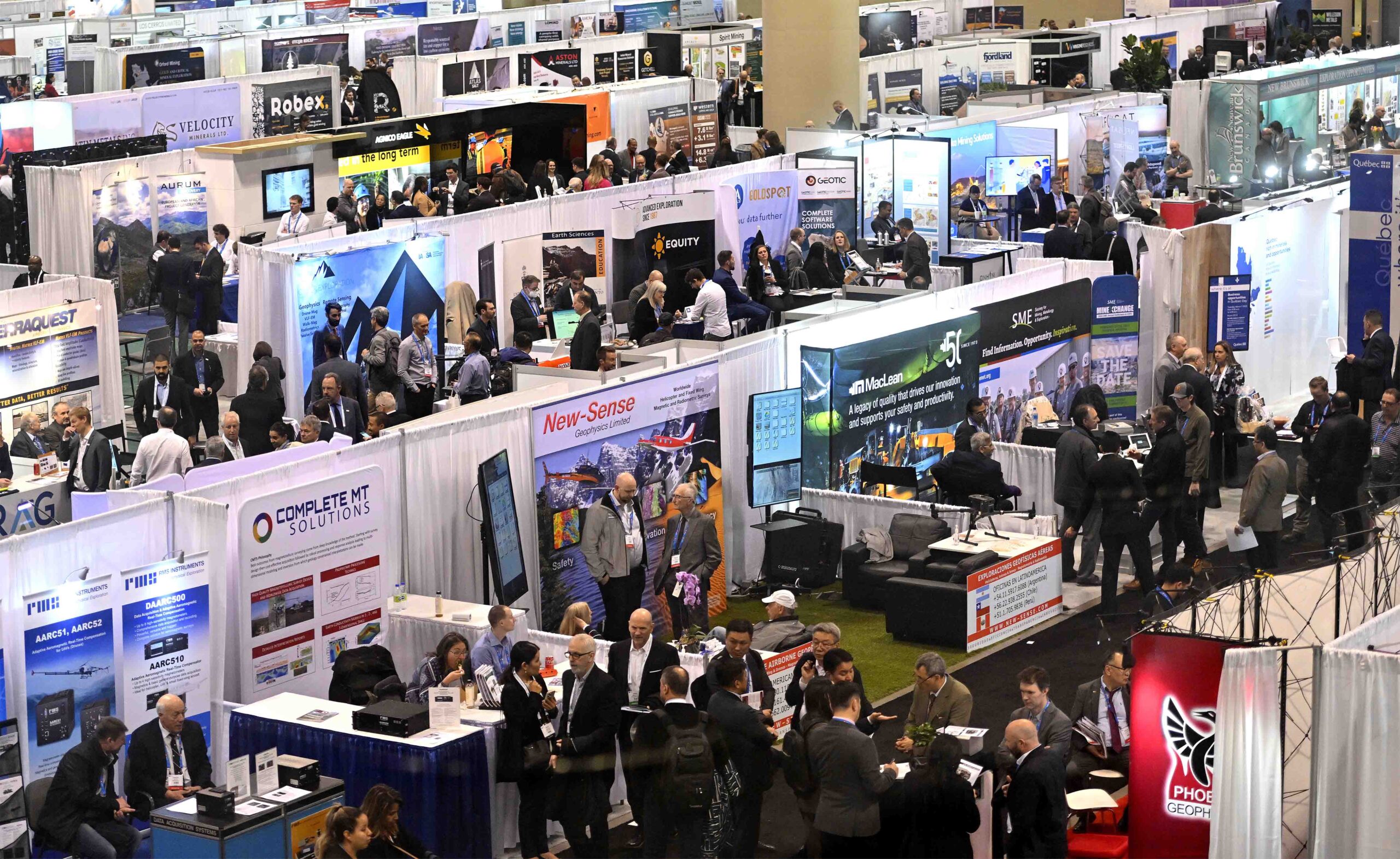Kazakhstan’s turquoise flag, featuring a golden eagle and bright sun, flew proudly in Toronto, Canada, from March 3 to 6 at the Prospectors & Developers Association of Canada (PDAC) conference, the world’s largest mineral and mining convention.

Twenty-five delegates communities attended the PDAC, Prospectors and Developers Association of Canada conference held earlier this month in Toronto. Photo credit: Facebook/Prospectors and Developers Association of Canada
Kazakhstan holds a place of significance amongst mining nations due to the abundant wealth hidden in its rocks and soil. The country has rich reserves of zinc, chrome, uranium, manganese, gold and much more.
During my time at the Toronto PDAC conference, I had the chance to meet face-to-face with leaders in Kazakhstan’s mining industry. This gave me a unique chance to explore a fascinating and economically vital part of the Kazakh economy.
A governmental perspective

Assel Nussupova.
Minister of Industry and Construction Kanat Sharlapayev, who led the Kazakh delegation in Toronto, told us that Kazakhstan can play an important role in the global mining industry. The numbers he cited painted a picture of an industry that is operating on a large scale.
He noted that around 220,000 people are currently working in the mining industry in Kazakhstan and 1.5 million square kilometers of land is open for geological exploration.
Minister Sharlapayev stated that mining today is one of the most significant sectors of the Kazakh economy, with aluminum, copper, zinc and lead being the top mining commodities. The mining sector today delivers $18.8 billion in export revenues to Kazakhstan. Where are these exports sent? The major markets for Kazakh mining commodities are found in China, Russia, Turkiye, Uzbekistan, the United Kingdom, the United Arab Emirates and Japan.
There is no question that Kazakhstan is blessed with resources, from lithium to gold. The treasures of the earth require careful and expensive extraction. What companies are playing a role in tapping into Kazakhstan’s mineral abundance? Arras Minerals of Canada, London-based Rio Tinto, Glencore from Switzerland, IG Kazakhstan, Perth-based Fortescue, Turkiye’s Yildirim, United Kingdom’s East Star Resources, Pallas Resources, Australia’s Sarytogan Graphite, and Turkiye’s Esan Eczacibasi are some well-known foreign companies that are currently working in Kazakhstan’s mining. Minister Sharlapayev views the involvement of these big-name companies as a solid indicator for Kazakhstan to be considered an attractive place for foreign investment.
Minister Sharlapayev said that in 2023, mining companies in Kazakhstan invested 1.45 trillion tenge (roughly $3.2 billion). Over the course of three years, Kazakhstan has launched several projects related to mining, including a new coal enrichment plant and the first ore-smelting ferroalloy furnace. The country has also modernized a gold processing plant and opened new processing facilities.
He informed us that the Kazakh government has taken concrete steps to improve Kazakhstan’s appeal for foreign direct investment in the mining sector. In particular, changes in the sub-soil legislation and the implementation of the CRISCO (Corporate Responsibility for Sustainable Coal Mining) standards have been instrumental in aligning the Kazakh mining sector with best international practices and attracting foreign companies. As a result, investment in the Kazakh mining sector has jumped from $30 million in 2018 to $82 million in 2022.
The roads of the mining sector in Kazakhstan, however, are not paved with gold. Despite the significant progress achieved by Kazakhstan over the last five to six years, Minister Sharlapayev shared with us that the country’s mining sector is still experiencing some problems. One difficulty is that Kazakhstan’s geological potential is still unknown, owing to a lack of data. Modernizing legislation governing environmental and safety standards for mining in Kazakhstan is another issue to be faced, according to Minister Sharlapayev.
Minister Sharlapayev also touched on the thorny issue of the risks related to trade with Russia. He mentioned that the sanctions against Russia have caused some logistic and supply chain distortions, but at the same time they have also opened up opportunities for Kazakhstan to trade with Europe, an area that used to be an active consumer of Russia’s metals and minerals. To explore such opportunities, Kazakhstan will benefit from the development of the Trans-Caspian corridor, opening access for Kazakh commodities to reach the ports of the Black Sea.
Minister Sharlapayev noted that despite geopolitical tensions, Kazakhstan’s mining sector is remaining in a safe zone and is still very attractive for foreign investment. This is especially true for the critical mineral sector. He said that Kazakhstan processes 18 of 34 critical minerals needed for the European market and 17 of 30 minerals critical to the U.S. economy.
Steps to improvement
After the governmental perspective offered by Minister Sharlapayev, I was interested to hear the viewpoints of company leaders and business people in the industry. Dr Kanat Kudaibergen, former head of the Tau-Ken Samruk National Mining company, had insights from his many years in the sector. He noted that despite the huge contribution the mining sector makes to the country’s GDP (at slightly over 15%), mining has a “great opportunity to increase its share in the economy as only 35% of the territory has been explored.”
Recognizing that Kazakhstan is undertaking serious steps towards improving the investment climate, Dr Kudaibergen said that there are still “challenges and risks for foreign investors” and the “government needs to continue addressing these issues to attract more investment.”
In his opinion, Kazakhstan must focus on the following steps: launching new taxes in the form of royalty instead of the current mineral extraction tax; increasing the availability of geological databases and supporting their digitalization; expanding sources of finances for mining exploration such as attracting private equity funds or stock exchange mechanisms. Dr Kudaibergen also stressed the need for “further provision of transparency and simplification of license obtaining procedures as well as stimulating the development of the junior mining sector and intensifying exploration works.”
The importance of infrastructure
One of the key issues for the Kazakh mining industry is the development of infrastructure. Road and rail networks, access to power and water and ports, are essential in developing mining projects in any country. For Kazakhstan with a territory that stretches across vast Eurasian steppes, having adequate infrastructure is a crucial factor for successful mining. According to Dr Kudaibergen, “the government provides appropriate programs for developing infrastructure and maximizing the transit potential of the country.” He said that in Kazakhstan, “over 2,000 kilometers of railways and highways have been constructed,” and there is a huge potential if the One Belt, One Road program proves to be beneficial.
Traditionally, Kazakhstan’s mining companies supply metals and minerals to China, other Asian economies and Russia. However, according to Dr Kudaibergen, “In the last two years, the European market has shown vast interest in our mining production, particularly in critical minerals.”
According to Dr Kudaibergen, there is hope that a significant increase in interest from Western companies in the United States, Canada, and Europe that are switching their focus from Russia will bring numerous benefits to the Kazakh mining industry.
I also had the chance to sit down with Said Sultanov, CEO of Aurora, a privately owned mining company in Kazakhstan. Sultanov believes that the mining sector has great potential and can truly become a driver of economic growth for the country. Sultanov stated that since the implementation of the new sub-soil usage legislation in Kazakhstan in 2018, the mining sector has begun experiencing an investment boom.
He did not, however, paint an entirely rosy picture of the industry. Sultanov noted that it is facing serious problems, including a lack of high-quality geological information, bureaucratic barriers slowing needed ecological legislation, flaws in the legislation on processing industries and a deficit of qualified skilled workers.
Sultanov believes that with the new leadership at the Ministry of Industry and Construction, it will be possible to overcome such hurdles. There are promising signs of progress, such as efforts to improve access to geological information and work being done to change the legislation to have a more equitable distribution of royalties from exploration. Programs are also being developed aimed at attracting new professionals to the mining industry and providing them with education.
In talking with Paul Renken, mining analyst for VSA Capital, an international investment banking and broking firm based in London and Shanghai, I learned more about current risks for the Kazakh industry and the promise of new technologies. Renken believes that for Kazakhstan, “one of the real risks is the simple fact it is a very large country geographically with a small population between two world political powers.” In his words, “no other country in the world quite has that “exposure and risk.” However, he observed, “that said, President Tokayev seeks to ‘steer his own path’ independent of Russia and China’s excess influence as it is the West which will benefit his economy the most across sectors.”
Emerging technology and a skilled workforce
Renken brought to my attention some of the emerging technology in the mining industry. He noted, “these developing technologies of merit in the mining industry showing great promise but not yet widely deployed globally: direct lithium extraction (DLE), In-Situ leaching (ISL), Downhole geophysics, driverless transport, battery-powered mining equipment, remote operator consoles, predictive maintenance software (AI), drone surveying, robotic equipment.” In the future, Kazakh mining companies may adopt such technologies, and that would require significant amounts of foreign investment.
Renken also discussed the human aspect of mining, noting a strength in the Kazakh workforce. He emphasized that “one particular advantage in Kazakhstan over other nations for mining labor is the trilingual education of the workforce. This added flexibility in understanding and business operations helps make up for a general small population pool to choose from.”
Challenges
Michael Beare, founder of Mike Beare Associates, a mining company operating in Kazakhstan, believes in the huge potential of the mining industry in Kazakhstan. He spoke in detail, however, about the challenges the industry is facing. Beare raised concerns about aging assets that will soon need recapitalization.
He observed, “Soviet-era assets are still the key metal producers and operate many facilities that date from the period before 1991.”
Beare shared his view that “these large producers are facing either the challenges of investment in mature mines and plants or the prospect of closing these facilities with serious implications to their host communities.” Beare added that “at the other end of the spectrum, there are relatively few players exploring for new deposits and mines. Aside from one or two players, Kazakhstan does not have a significant junior mining sector where small companies are actively generating a pipeline of new projects.”
While positive about President Kassym-Jomart Tokayev’s agenda to increase the focus on mining and make it a real driver of Kazakhstan’s economic growth, Beare thinks that the government “needs to appreciate the negative impact that high royalties have on investment.”
My recent conversations in Toronto with leaders and experts in the mining sector gave me a glimpse into the exciting potential, promising future and current challenges of the Kazakh mining industry. Kazakhstan is making serious strides towards increasing the attractiveness of the mining sector for foreign investors. This aligns well with President Tokayev’s reform agenda, which welcomes foreign investment. The government is working to provide foreign investors with more confidence in the consistent and transparent management of key factors in the sector. In a world hungry for critical minerals, Kazakhstan has a bright future if it can provide the mining industry with the support it requires to grow and thrive. In years to come, the Kazakh flag will wave over many vital mining projects, unearthing minerals destined for far-flung parts of the globe.
The author is an analyst holding a Master’s Degree in Economics from Georgetown University in Washington, D.C. With more than 20 years of experience working for the Kazakh government, she specializes in macroeconomics, commodity, financial markets, as well as economic and social policies in Kazakhstan and globally.
